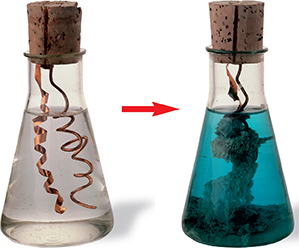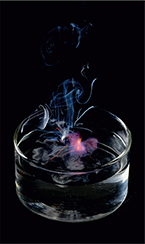Figure 11 A single-replacement reaction occurs when copper wire is submerged in a solution of silver nitrate. As the copper replaces the silver in the silver nitrate solution, the solution turns blue, and silver crystals form on the wire.

Figure 12 Potassium reacts with water in a single-replacement reaction that produces hydrogen gas and potassium hydroxide.

Single Replacement
A single-replacement reaction is a reaction in which one element takes the place of another element in a compound. Single-replacement reactions have the general form
Suppose you dip a coil of copper wire into a solution of silver nitrate and water, as shown in Figure 11. A vivid chemical reaction takes place as the solution turns blue and the submerged part of the wire becomes coated with a silvery metal. In this reaction, the copper replaces the silver in silver nitrate to form copper(II) nitrate. The equation for this reaction is
Notice that one of the products is silver, which you can see adhering to the wire in Figure 12. The other product, copper(II) nitrate, gives the solution its blue color.
Recall that alkali metals are very reactive elements. Figure 12 shows potassium reacting with water. This is another example of a single-replacement reaction, as the element potassium replaces hydrogen in water to form potassium hydroxide, KOH.
The heat produced by this chemical reaction causes the hydrogen gas to ignite explosively.

What is a single-replacement reaction?




